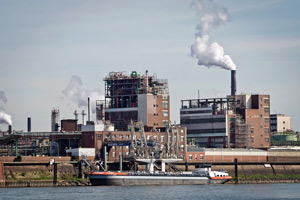Industrial Waste Water Treatment-- Efficient Waste Administration for Manufacturing Facilities
Wiki Article
Developments and Breakthroughs in Industrial Waste Water Treatment Technologies
The landscape of commercial wastewater therapy is undertaking a transformative change, driven by innovations that enhance both efficiency and sustainability. As governing standards evolve, the integration of AI and device knowing into wastewater management systems promises to guarantee and improve operations compliance.Review of Drainage Therapy Technologies
Wastewater therapy technologies encompass a variety of methods made to get rid of pollutants from industrial effluents before their launch right into the atmosphere. These innovations are vital for preserving ecological equilibrium and making certain conformity with environmental laws. The key classifications of wastewater treatment consist of physical, chemical, and organic methods, each offering unique functions based on the nature of the impurities present.

Biological therapy approaches employ bacteria to weaken organic issue, making them particularly effective for organic-rich effluents. Techniques like activated sludge and biofilm reactors harness the natural destruction capacities of microorganisms, leading to considerable reductions in biochemical oxygen need (FIGURE)
Advanced Purification Strategies
Advanced filtration techniques represent an important advancement in the world of commercial wastewater therapy, improving the efficiency of pollutant elimination procedures. Industrial Waste Water Treatment. These approaches encompass a series of modern technologies, consisting of microfiltration, ultrafiltration, nanofiltration, and turn around osmosis, which give sequential obstacles for different bit sizes and chemical frameworksMicrofiltration and ultrafiltration utilize membrane systems to remove put on hold solids, microorganisms, and larger natural particles, improving the top quality of effluent prior to more therapy. Nanofiltration links the space between ultrafiltration and reverse osmosis, effectively removing organic compounds and divalent ions, thus reducing the lots on downstream procedures.
Reverse osmosis provides the highest degree of filtration by enabling only water and small particles to pass with its semi-permeable membranes, making it perfect for reclaiming high-quality water from commercial effluents. Recent developments in membrane modern technology, including the development of even more fouling-resistant and durable products, have significantly boosted operational performance and minimized expenses.
Including these sophisticated filtration strategies not only boosts the general therapy process yet likewise adds to sustainability efforts by enabling water reuse and resource recuperation in industrial setups. (Industrial Waste Water Treatment)
Biological Therapy Developments

In addition, the advancement of engineered organic systems, such as membrane bioreactors (MBRs), combines organic treatment with innovative membrane filtration. This integration enables higher effluent top quality and minimized footprint, making it appropriate for space-constrained commercial centers. Technologies in genetically crafted microorganisms have actually also arised, improving the biodegradation of details pollutants, such as drugs and heavy steels, that are typically testing to eliminate.
In addition, the implementation of bioaugmentation approaches, where helpful microbes are introduced to enhance the existing biological therapy processes, has actually shown promising lead to improving treatment efficiency. These innovations jointly indicate a pattern in the direction of even more efficient and sustainable organic treatment methods that can adjust to the developing intricacies of commercial wastewater streams. As industries remain to prioritize environmental compliance, these biological innovations will play a vital duty in wastewater management.

Source Recovery Approaches
In commercial settings, the assimilation of resource recovery approaches has become significantly important for enhancing sustainability and decreasing waste. These techniques focus on removing important products and power from wastewater streams, thereby changing prospective toxins into reusable resources.One prominent technique is nutrient recuperation, where nitrogen and phosphorus, typically existing in excess in wastewater, are recorded and converted right into fertilizers. This not only reduces environmental impacts yet also gives a circular economic climate solution for agricultural applications. In addition, technologies such as anaerobic food digestion allow for the conversion of organic waste right into biogas, a renewable energy resource that website link can counter fossil fuel use in commercial procedures.
Additionally, progressed purification and membrane modern technologies facilitate the healing of commercial byproducts such as salts and metals. These recuperated products can be rehabilitated into manufacturing procedures, reducing the requirement for virgin resources.
Future Trends in Waste Water Monitoring
As sectors increasingly prioritize sustainability, the future of wastewater administration is readied to go through substantial transformations. Technological improvements, such as expert system and artificial intelligence, will certainly make it possible for more efficient monitoring and Get More Info management of wastewater systems. These innovations can anticipate maintenance requirements, enhance treatment processes, and improve decision-making, eventually decreasing operational expenses and environmental impact.Furthermore, the combination of circular economic climate concepts will play a vital function in wastewater administration. Industries are expected to move in the direction of systems that not just treat wastewater however likewise recover valuable resources, such as nutrients, water, and power. This transition will certainly lessen waste and advertise the reuse of materials, aligning with global sustainability objectives.
Arising treatment methods, such as membrane bioreactors and progressed oxidation procedures, will even more enhance the performance of wastewater treatment, permitting higher top quality effluents appropriate for reuse. Furthermore, regulatory structures are most likely to develop, emphasizing more stringent requirements for wastewater discharge and encouraging industries to take on cutting-edge therapy options.
Final Thought
In conclusion, the advancement of industrial wastewater therapy useful link technologies shows a considerable shift towards enhanced performance and sustainability (Industrial Waste Water Treatment). Developments in sophisticated purification techniques, biological treatments, and resource healing approaches highlight the sector's commitment to environmental stewardship.The landscape of industrial wastewater treatment is going through a transformative change, driven by technologies that boost both efficiency and sustainability.Wastewater treatment innovations encompass a range of methods developed to eliminate pollutants from industrial effluents before their release into the atmosphere.Taking advantage of the power of biological processes has led to significant developments in the treatment of industrial wastewater.Additionally, the implementation of bioaugmentation strategies, where advantageous microbes are introduced to enhance the existing biological therapy procedures, has actually shown appealing results in improving therapy efficiency. These advancements collectively represent a trend towards even more effective and sustainable organic therapy methods that can adapt to the evolving intricacies of commercial wastewater streams.
Report this wiki page